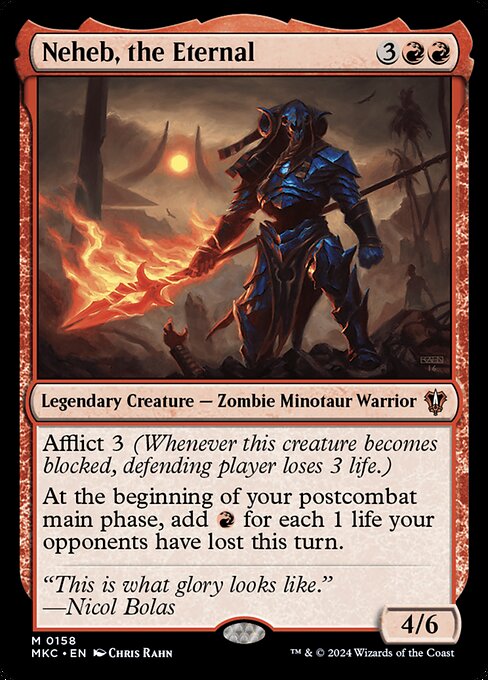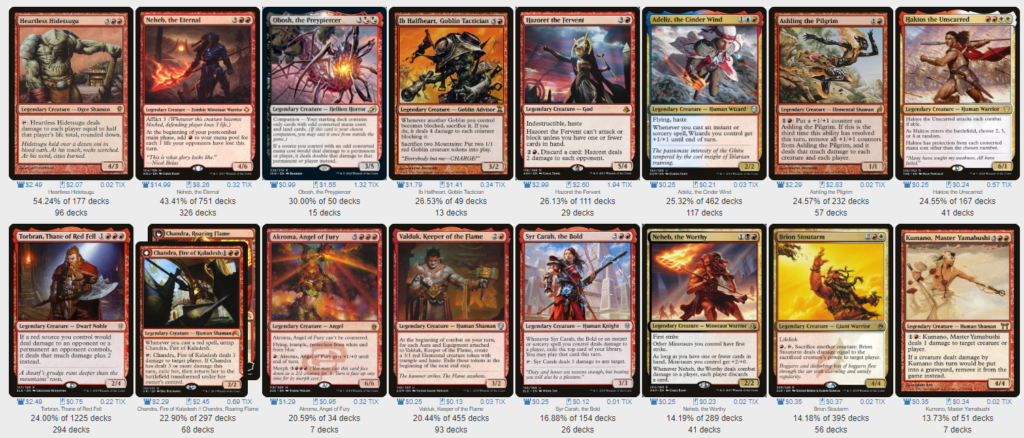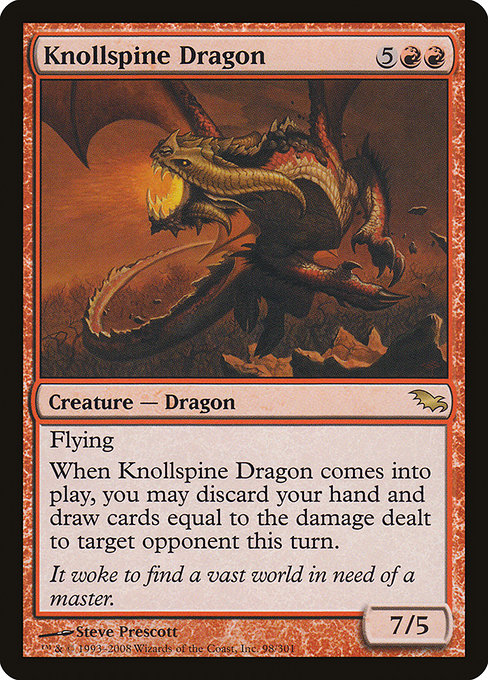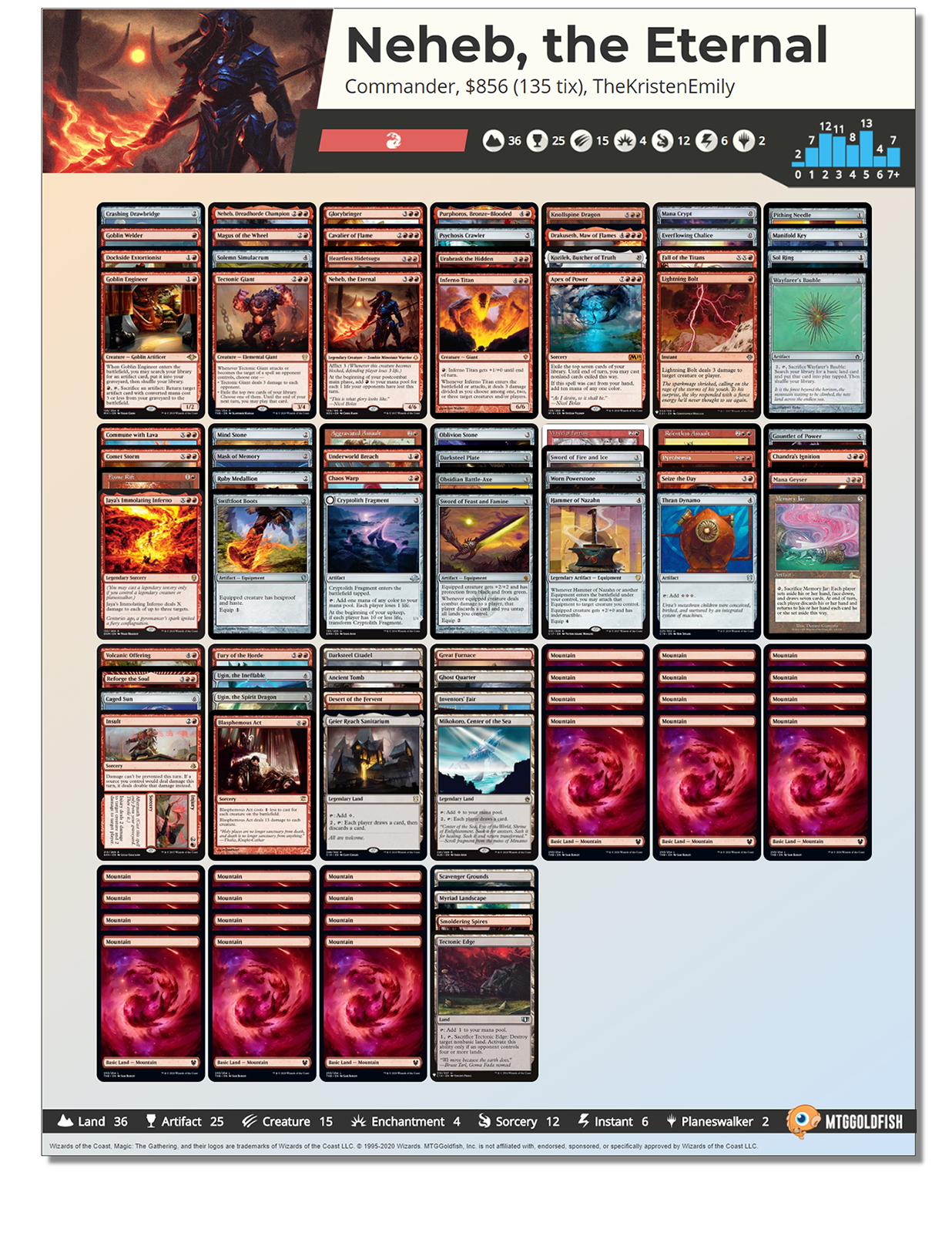This week, we look at five Red cards Kristen thinks should see more play, plus her Neheb, the Eternal deck that runs them.
Last week’s article struck a chord with many of you, but it’s time to go back to EDH this week. Despite the lockdown getting in the way of jamming as many games as I’d like, I’ve still found time to get some use out of my webcam EDH set up. Moving my games over to webcam has been largely successful, though scheduling them has been another story! The main hurdle has been the fact I can’t play my Chainer, Nightmare Adept deck. It has one too many cards like Etali, Primal Storm and Gonti, Lord of Luxury that make gameplay needlessly difficult when playing remotely. It’s a favorite of mine, and so there’s been a bit of a “hasty, splashy” itch to scratch. Enter Neheb.

Neheb has quickly become one of my go-to Commanders when I want to have some fun. He plays in a really interesting design space: making big mana through dealing damage. Your goal with the deck is essentially to start pushing a snowball, and hope it rolls downhill faster than your opponents can stop you. The lines of play are fundamentally Red in nature; you’re either dealing massive amounts of damage to face, or gambling and pushing your engine to the limit to try and find what you’re looking for.
There’s no better way to showcase some Red cards I think deserve more play than to share this deck with you, so let’s get things rolling. First, we’ll look at the cards themselves:
Insult to Injury
Let’s face it: the number one way to annoy a combat-focused deck is to play a Fog. Fogs are generally bad cards, especially in Draft; but in Commander, the ease of recurring them can mean many decks are happy to run them. From Spore Frog to Constant Mists, and all of the utility cards (such as Druid’s Deliverance) in between, there’s plenty of ways to have the combat deck at the table feel like they’re banging their head against a brick wall. You’ll most often find these effects in the Jund portion of the color pie, particularly in land-based decks like The Gitrog Monster or Lord Windgrace, where they’ll be able to reset Glacial Chasm too.
Doubling damage has always been a good way to end a game in short order, so rolling Insult // Injury up with a way to get around Fog effects is a winner in my book. If you have a mana to spare, the aftermath gives us a removal spell too. It’s an efficient and fair-costed card, and it’s criminally underplayed. I think some of the reason for this is that it competes with the flex slots in decks, and oftentimes misses the final cut when you’re short on more critical effects.
Looking on EDHRec, we can see that the card is played mainly in decks that specialize in dealing damage, directly or indirectly:

I’d like to challenge that notion and suggest it deserves more play in general combat focused decks. Commanders like Xenagos, God of Revels and Aurelia, the Warleader love to deal damage and hate fogs; and what’s more, only 7% of Gisela, Blade of Goldnight decks run Insult // Injury, which is bonkers given it’s a redundant effect.

Urabrask, the Hidden
Haste is one of the most underrated abilities in Commander, and I’d argue it gets more relevant as time goes on. Threats get cheaper, removal is more efficient, and you can no longer bank on being able to untap with your board—in fact, untapping at all is often the more pressing issue. A good offense is a good defense, and Urabrask encapsulates that maxim with ruthless resolve. Granting your team haste whilst simultaneously ensuring opponent’s creatures come in tapped ticks all of the boxes, and I’m surprised the Red praetor doesn’t see more play.
People are happy to run Authority of the Consuls or Blind Obedience; oftentimes when those decks are Boros at least, combat is on the menu. Urabrask is also great in any decks with reanimator engines—Anger can be a liability and paint an early target on your bin, and sometimes you won’t have enough mountains to make it useful. Urabrask can fulfill your needs handily here, while also being a way to protect yourself from an opponent’s hasty deployment of a token army or combo.
If you’d like to read more about the deck that loves haste, check out this Chainer, Nightmare Adept deep dive I prepared earlier.

Knollspine Dragon
Everybody loves drawing cards, right? Knollspine Dragon rewards you for dealing damage by giving you that many cards, for the cost of seven mana and discarding your hand. I can see why this card sees most of its play in Dragon tribal decks, but I’m struggling to understand why only 44% of Neheb decks run it. It’s a powerhouse in Neheb to be sure, but I think it sees far too little play. Hopefully the Mystery Booster reprint can get this card into the hands of more players.
There are countless damage/combat focused decks that would love to be able to refill their hand so greedily. The most egregious misstep I can see here is that only thirteen of the over 800 Nikya of the Old Ways decks are running this card, which is just madness. How else are you planning on drawing cards with only creatures? Beast Whisperer is fine, but Knollspine Dragon is king, especially in a deck capable of making big mana.

Mana Geyser
Mana Geyser has hit my radar recently as an ever more relevant card. With Green based decks ramping out lands so consistently these days, being able to convert five mana into fifteen plus is relatively easy. It’s an interesting card to evaluate, because historically, it’s been more at home in combo or big mana decks. I’d argue that that’s no longer solely the case. With the format having sped up by as much as a whole turn on average—in the sense that the average casual deck is now way more consistent—being able to have a single explosive turn is now a much higher priority for decks that want to play fair.
Mono Red decks can of course use this mana in the easiest way, but Mana Geyser is also great in Rakdos decks, and even Boros decks. The latter have become more relevant thanks to Smothering Tithe and the use of “wheel” effects over the top. Mana Geyser is another way to gain such a mana advantage without needing two cards to pull it off.
Of course, the beauty of Mana Geyser is being able to replay it. To do that, you’ll need the next card.

Underworld Breach
While Underworld Breach is very much a known entity, I think a lot of people have written it off as strictly a combo card. Most people will of course be familiar with its role as an enabler in combos that aim for storm, self mill, or mana generation. While it does in the classical sense enable some degenerate lines of play; I think more than that, it’s pure value.
With access to a wheel effect and a mana generator, there are a lot of lines of play open to you. The easiest to assemble in mono Red is Wheel of Fortune and the aforementioned Mana Geyser—but honestly? There are many cards that can get in on the fun, with Dockside Extortionist being one of the better options if you have a sacrifice outlet available.
Of course, “going off” is always the ceiling of a card like this, but it should make the first draft of most decks that play Red purely because of its utility as a way to enable recursion. Even being able to cast a second Path to Exile by exiling three cards from your graveyard and paying 1RW in total isn’t the worst use case, and goes up from there. Most RWx decks should be running it if they’re running Sun Titan, for instance—currently only one Aurelia deck on EDHRec runs both Sun Titan and Underworld Breach, so Boros mages have a lot of catching up to do!
Now you’ve heard my calls for under-utilized Red cards, let’s put them in to practice.
Neheb, the Eternal
Neheb is a big mana deck that wants to light a fire, and keep it burning. The goal of the deck is to generate enough mana to cast a huge burn spell to eliminate our opponents in one fell swoop, with a backup plan of putting that mana into Aggravated Assault for infinite combats. To get there, the deck takes advantage of multiple large draw spells, extra combat spells, and ways to generate mana efficiently.

Once we generate enough mana, we can shoot our opponents in the face with Comet Storm, Fall of the Titans, or Jaya’s Immolating Inferno. Insult // Injury can halve the mana investment we need; while Flame Rift, Cryptolith Fragment, Pyrohemia, and Heartless Hidetsugu can hurry things along.
The most reliable way to get big mana is to take an extra combat. More attacks mean more loss of life. Aside from Aggravated Assault (which can be powered by Sword of Feast and Famine in a pinch); we’re running Relentless Assault, Seize the Day, and Fury of the Horde. The flashback and alternate casting costs can really help us stretch things out.
Of course, to play this kind of strategy, we need to draw into the right cards. Beyond the “top ups” we can get from Mask of Memory and Sword of Fire and Ice, we mainly concentrate on big, splashy refills to maximize the chance we hit our outs. Apex of Power, Commune with Lava, Knollspine Dragon, and Kozilek, Butcher of Truth join the classic wheels: Wheel of Fortune, Magus of the Wheel, Reforge the Soul, and Memory Jar. We can always tutor out the latter with Inventors’ Fair, or get it back using Goblin Welder or Goblin Engineer to help keep things rolling. To take advantage of all the cards drawn, Psychosis Crawler doles out life loss for each one, helping us with our gameplan.
Haste is pretty key, so we play Urabrask, Crashing Drawbridge, Swiftfoot Boots, Obsidian Battle-Axe, and Purphoros, Bronze-Blooded. Purphoros doubles as an attacker that won’t die, so can help in generating mana when we need to keep swinging into other creatures; similarly, Glorybringer can snipe problem blockers out of the way.
Suiting up Neheb with Darksteel Plate or Hammer of Nazahn allows him to survive even Blasphemous Act or Oblivion Stone. Sometimes we’ll have to hit the reset button if we don’t go off quick enough; so alongside those, we also have Chandra’s Ignition and Ugin, the Spirit Dragon, which can clear the way for Neheb to get in. Ugin, the Ineffable also gives us as a bonus way to deal with enchantments while providing cost reduction and card advantage too. Volcanic Offering and Chaos Warp round out our removal, with an old fashioned Lightning Bolt for good measure.
To enable all of this we have a strong ramp suite that combines cheap and effective faster mana with high-end mana doublers like Gauntlet of Power and Caged Sun. I’d love to add Gauntlet of Might, but my collection only stretches so far. Speaking of which, swapping out Mana Crypt for Seething Song is a totally fair substitution; depending on the table, Red Elemental Blast might be appropriate to sub in too.
Rounding things out we have a couple of utility artifacts in Pithing Needle and Manifold Key. Beyond being cheap and weldable, they exist to help enable us to go off in spite of early game threats that may otherwise derail us. Dropping Pithing Needle against Lord Windgrace feels particularly good.
We can’t round out the breakdown without talking about Underworld Breach, though. With the deck built like it is, Underworld Breach should win us the game most of the times we’re in a position to cast it. Combining wheel effects with the bounty of mana available to us from Neheb and Mana Geyser means we’re never far away from what we need. This deck is a blast to play, and has made a home for itself in my permanent rotation due to how unique it plays compared to my other lists. I’m all about keeping gameplay fresh.
Got any more shouts for underplayed Red cards? Or maybe you enjoy playing Neheb? Let me know on Twitter to continue the discussion.
Based in the UK, Kristen is a lover of both Limited and Commander, and can most often be found championing the Boros Legion when called upon to sit down and shuffle up.

